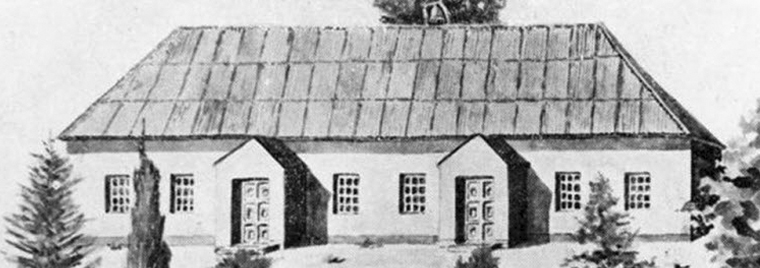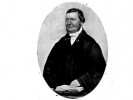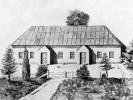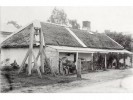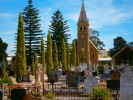Our History Book “The Story of Langmeil 1843 – 2013”,
launched by Don Ross at the 125th Anniversary Service on November 24th 2013
is available for purchase. Click here for more information.
The Langmeil story begins in the 1830’s, in Prussia. At that time Friedrich Wilhelm 3rd, the King of Prussia, tried to force the Lutherans to unite with the Reformed Church. They objected for reasons of faith, but were forbidden freedom of worship.
Pastor August Kavel was originally an ordained Pastor of the Union Church and served the parish of Klemzig in Brandenburg, Prussia. After studying the writings of those Lutherans who opposed the Union Church, Kavel resigned from the Union Church and was ordained as a Lutheran Pastor. (Under the Kings’ rule this was illegal.) Many of his parishioners remained faithful to him and held services in private homes and in the forests. Those caught attending these services were fined and imprisoned.
Pastor Kavel hoped to take his people to a land where they would have freedom of worship. His first choice was Southern Russia, but when that was impossible, he went to Hamburg seeking passage to America. After failing to find a sponsor, he went to London to seek George Fife Angas’ help. Angas a London merchant was chairman of the South Australian Company which was set up to facilitate the establishment of the new colony of South Australia founded in 1836.
Angas a sincere Christian saw Kavel and his people as being ideal settlers for the new colony and agreed to financially assist their emigration. Pastor Kavel was in England for 2 years because the Prussian King refused to grant passports to the Lutherans.
Mr. Angas sent his confidential clerk Charles Flaxman with Kavel’s people to supervise their settlement. The 520 people in the Kavel group came to South Australia on several ships arriving late 1838 and early 1839. They settled at first near Adelaide on the banks of the Torrens naming their settlement Klemzig. Some moved on to the Adelaide hills founding Hahndorf.
After hearing the good reports of Johannes Menge the German mineralogist and explorer and knowing that Kavel’s people were keen to settle on this land Flaxman bought 28,000 acres in the Barossa, with Angas’ money.
Before the land could be settled it needed to be surveyed which took about 2 years, meanwhile the people living at Hahndorf had become settled and did not want to move.
After considerable negotiation it was agreed that Kavel’s people could lease some of Angas’ land with the right of purchase.
In 1843 a group of Lutherans settled at Langmeil, which is named after a village in Brandenburg, Prussia near Klemzig. The first activity of the new congregation was the building and establishment of a Lutheran School in 1845 (see photo below); it was the first building in the area. The Tanunda Lutheran School is on the same site. Pastor Kavel’s brother was the first teacher. In 1863 there were 38 children attending. Lessons were taught in German and English until the anti German hysteria of World War I caused the Government to close the school in 1917. The school reopened in 1938 and is supported by all the Lutheran churches in the area, with an enrolment of over 200 students. Langmeil is a supporting congregation of Faith Lutheran College, a secondary school with an enrolment of over 600.
During the 1840’s many more Lutherans migrated to South Australia, having been encouraged to do so by the good reports sent home by the original settlers. As settlement in the Barossa increased new congregations were formed at Light Pass, Gnadenfrei, Nain, Gruenberg and North Rhine; all initially were served by Pastor Kavel from Langmeil.
A split occurred in the congregation after Pastor Kavel died in 1860 because of disagreement regarding Kavel’s successor. One section of the congregation wanted J. Christian Auricht, who was Kavel’s student and who supported Kavel’s constitution. The other group led by Elder Rieschieck wanted Pastor Staudenmayer of Light Pass, who had differences with Kavel.
The whole matter of the constitution is fairly involved, as Kavel wanted to emphasise that the church should not be governed by rulers, as in Prussia. Most of those who broke away were not part of the original migration with Kavel, but were people who joined the congregation later. The break away group worshipped in Rieschieck’s house in Goat Square for two years, before moving to the present St. John’s site.
Many Langmeil members also left to form new settlements in other parts of the state, particularly after 1870. A group of Langmeil members established the settlement and congregation at Sedan on the Murray Plains; these were served from Langmeil for many years.
This led to the fact that there were only 70 communicant members in 1888, when the present church was built. In a courageous act of faith a new Dankes Kirche (Thanksgiving Church) was built to mark the 50th Jubilee of the establishment of the Lutheran Church in Australia. The dedication of the new church took place on November 25th, 1888. Members of the Angas family financially supported the building of the new church. A hall was built in 1960, and it is now incorporated in the Langmeil Centre.
Pastor Auricht edited a church periodical “Kirchen und Missions Zeitung”; he purchased his first printing press in 1868, and a printing office was erected, (still standing) next to the Langmeil Manse. Pastor Auricht’s son established Auricht’s Printing Office in Murray Street, Tanunda, in 1884; here church literature in both German and English was printed for many years.
We draw your attention to the windows of our Church. The first memorial window in the northern wall depicts three aspects of the life of the Lutheran Church in Australia – its faith, its missions outreach and the Christian education of the young. The face of Pastor Kavel (centre), the founder of the Church, recalls that our pioneer fathers migrated for faith and conscience sake. The on-going mission of the Church – “to preach the gospel to all people” is represented by the portrait of Dr. John Flierl (left) who was commissioned in Langmeil in 1885 to serve as the first missionary ever to set foot in New Guinea. On the right is Pastor G.F. Leidig, the founder of Immanuel College. The second stained window in the northern wall portrays the pilgrimage of every Christian as they journey towards their heavenly home.
In the “pulpit window” we see Christ who constantly knocks at the door of each heart through the preaching of the Word of God, which is the “Light of Life”. The absence of an outer door handle reminds us that each heart must be opened from within. The altar window was placed in the Church in 1938 to mark the centenary of the Lutheran Church in Australia. It is surely fitting that the figure of Christ should dominate the Sanctuary, and indeed the whole Church. He who is Lord of his Church is also the strength and hope of his people.
Langmeil has always had a keen interest in mission work. Two missionaries, Goessling and Homann, were sent out with lay helpers from Langmeil, to work among the aboriginals of the Dieri Tribe in the Centre in 1866. Missionary Flierl was sent out from here to P.N.G. on 8/11/1885, and established the Lutheran Mission there. Pastor Leo Kalleske spent his entire ministry with the aboriginals in Areyonga, Central Australia. Another son, Ed. Tscharke worked in P.N.G. for many years as a medical missionary. Other sons of the congregation who were ordained were Dr. Siegfried Hebart, Pastor Len Tscharke, Pastor Brian Tscharke, Pastor Kym Mills and Pastor Graham Jenke.
The cemetery is of historic interest. It’s the resting place for more than 20 clergy plus their wives, including the ashes of an Anglican priest. Pastor Kavel’s mother and 2 brothers are also buried there, but unfortunately we do not know where, as there are no records prior to 1864.
The successors of Pastor Kavel at Langmeil have been; Pastor J. Christian Auricht 1860-1907, Pastor Theodor Hebart 1909-1952, Pastor Ivan D. Wittwer 1952-1960, Pastor Lawrence H. Leske 1960-1975, Pastor David F. Siegle 1975-1982, Pastor Leonard O. Gerschwitz 1982-1993, Pastor David H. Preuss 1993-2009. Pastor Julian R.M. Bayha 2010-2020.
At present Langmeil also employs an Administrative Secretary (Colleen Bryan).
The people of Langmeil today have a great love for their Lord and Saviour. We believe that we are a caring, growing and alive congregation. Langmeil’s mission statement is “Bringing the Hope and healing of Jesus to the community”. Our aim is to fulfil this vision, but at the same time we are conscious of the needs of our own congregation.
The present baptised membership is almost 500, made up of all age groups. We have felt the need to offer a variety of worship styles to meet the needs of our members and the community. We conduct two worship services each Sunday. The first at 8.45 a.m. is a traditional service. At 10.30 we have a contemporary service using a variety of worship orders.
At Langmeil, music plays a big part in our worship. In 1985 our choir celebrated its centenary of continuous singing at services. Our pipe organ which was dedicated in 1950 is used every Sunday at our Traditional worship services and we have several contemporary music groups.
The Langmeil Centre, dedicated in May 1992, gives us an ideal place for fellowship after services, and is used for various functions by the congregation and the community as well. We see this as another way we can have contact with the wider community.
We thank God for the many blessings we have received in the past, and pray that he will use us at Langmeil to bring many people to accept him as their Lord and Saviour. (February 2016)
Thank you to Don Ross for providing this historical overview.

